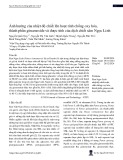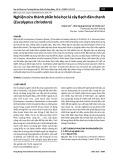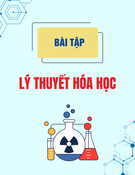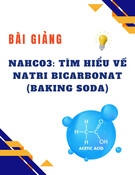
HPU2. Nat. Sci. Tech. Vol 04, issue 01 (2025), 12-19.
HPU2 Journal of Sciences:
Natural Sciences and Technology
Journal homepage: https://sj.hpu2.edu.vn
Article type: Research article
Received date: 18-11-2024 ; Revised date: 12-12-2024; Accepted date: 25-3-2025
This is licensed under the CC BY-NC 4.0
12
Optimization of extraction of flavonoid and polyphenol from
Camellia megasepala leaves and their anticancer activity
Xuan-Phong Ong
*
, Thi-Thuong Ngo, Viet-Hong La
Hanoi Pedagogical University 2, Vinh Phuc, Vietnam
Abstract
Camellia megasepala Hung T. Chang & Trin Ninh, found in Na Hang district, Tuyen Quang province,
contains a significant amount of flavonoids and polyphenols, which are important phenolic compounds
known for their various biological activities beneficial to human health, including antibacterial and anti-
inflammatory effects. This study applied the response surface methodology (RSM) to examine the
influence of extraction factors on the polyphenol and flavonoid content in golden tea leaves. The optimal
conditions for extracting polyphenols and flavonoids were temperature at 60°C, 70% ethanol
concentration, extraction time of 80 minutes, and a material/solvent ratio of 1/20 (w/v). The
experimental values were: flavonoid = 1.42 ± 0.0172 mgQE/g extract; polyphenol = 4.29 ± 0.0348
g/100g extract. The extract from golden tea leaves was evaluated for its cytotoxic activity against HepG2
liver cancer cells and A549 lung cancer cells. The inhibitory concentration (IC50) for the ethanol 70%
extract was recorded as IC50 = 74.11 ± 1.37 µg/ml and IC50 = 67.11 ± 1.57 µg/ml for HepG2 and A549
cells, respectively. The results of this study suggest the potential application of golden tea leaf extract
in inhibiting the growth of liver and lung cancer cells.
Keywords: Optimization, flavonoid, polyphenol, cancer, Camellia
1. Introduction
Yellow Camellia tea, derived from several species of the Camellia genus, particularly C. tienii and
C. sinensis, is gaining attention for its unique properties and potential health benefits. This tea is
characterized by its yellow flowers and leaves, which are rich in polyphenols and other beneficial
compounds. Camellia tienii has been shown to contain over 158 polar metabolites, including flavonoids
and catechins, which contribute to its medicinal properties [1]. Anti-Obesity Effects: Yellow leaf green
tea (YLGT) derived from C. sinensis has demonstrated significant anti-obesity effects in studies,
*
Corresponding author, E-mail: ongxuanphong@hpu2.edu.vn
https://doi.org/10.56764/hpu2.jos.2025.4.1.12-19

HPU2. Nat. Sci. Tech. 2025, 4(1), 12-19
https://sj.hpu2.edu.vn 13
modulating metabolic pathways and gut microbiota in mice [2]. The Central Highlands of Vietnam are
home to numerous yellow camellia species, with a high survival rate for cultivation, suggesting strong
potential for commercial tea production [3]. The growing interest in yellow tea products, such as large-
leaf yellow tea, highlights the economic viability of these plants within the food industry [4].
Optimization of extraction processes to obtain bioactive-rich compounds from plants is a topic of
interest in the research and production of herbal products. Response Surface Methodology (RSM),
coupled with data processing software, has become a valuable tool among modern experimental design
methods. It enables researchers to conduct multi-factor optimization studies, thereby saving both time
and costs [5]. The Box-Behnken design is a powerful statistical tool widely utilized in optimizing
extraction processes from plant materials, enhancing yield and efficiency. This method allows
researchers to systematically evaluate the effects of multiple variables on extraction outcomes, leading
to improved extraction conditions for various bioactive compounds [6]–[9].
Numerous studies worldwide focused on optimizing the extraction processes and production of
products from yellow camellia tea [10], [11]. However, in Vietnam, no research has yet applied
Response Surface Methodology to optimize the extraction of polyphenols and flavonoids from yellow
camellia tea leaves. Consequently, this study was conducted to provide foundational knowledge for
applying yellow camellia tea leaves as a resource in healthcare.
2. Experimental section
2.1. Materials
Yellow camellia tea leaves were collected from Na Hang District, Tuyen Quang Province. The
alcohol chemicals included ethanol (Vietnam), were provided by the Institute of Scientific and Applied
Research, Hanoi Pedagogical University 2.
2.2. Development of an optimized extraction protocol flavonoid and polyphenol from Camellia
megasepala leaves
The research process was carried out sequentially through the following steps: (1) Conducting
single-variable analysis of factors affecting the extraction process to select the survey limits and central
points of these factors (independent variables). (2) Designing and implementing an optimization
experimental model. (3) Analyzing experimental data. (4) Extracting yellow camellia tea leaves under
optimal conditions and comparing the results of the model with the actual experiment. (5) Determining
the polyphenol and flavonoid content in yellow camellia tea leaf extract under optimal extraction
conditions [5], [12].
Flavonoid determined using the color method AlCl3 by Sultana et al. (2007) with correction [13].
Polyphenol determined according to the method of Singleton et al. (1999) with correction [14].
Analysis of individual factors affecting the extraction process
Sequentially investigating the influence of ethanol concentration, extraction temperature (°C), and
extraction time (minutes) on the polyphenol and flavonoid content in the extract of yellow camellia tea
leaves. At each experimental step, the value of the factor under investigation varies while the other
parameters are kept constant; polyphenol and flavonoid content are then determined. This helps in
selecting the appropriate factor to use in subsequent experiments. The ethanol concentrations tested are
50%, 60%, 70%, 80%, and 90%. The temperature levels examined are 40°C, 50°C, 60°C, 70°C, and
80°C. The extraction times studied are 20, 40, 60, 80, and 100 minutes.

HPU2. Nat. Sci. Tech. 2025, 4(1), 12-19
https://sj.hpu2.edu.vn
14
2.3. Methodology for in vitro cell culture
HepG2 liver cancer cells and A549 lung cancer cells were used and cultured in DMEM or RPMI
media, respectively, supplemented with 10% fetal bovine serum (FBS) and 1% antibiotic solution
(penicillin 100 units/mL, 100 μg/mL streptomycin sulfate). The cells were cultured in an incubator at
37°C, 5% CO
2
, and the culture medium was changed regularly every 2–5 days depending on cell growth.
2.4. Cytotoxicity evaluation using the mtt assay
The MTT assay (3-[4,5-dimethylthiazol-2-yl]-2,5-diphenyltetrazolium bromide) was used to test
in vitro cytotoxic activity on HepG2 liver cancer cells and A549 lung cancer cells. HepG2 and A549
cells were seeded in 96-well plates at 10,000 cells/well density. The cells were incubated overnight to
stabilize the plates. Then, the compound under investigation was added in triplicate at different
concentrations, from low to high. Dimethyl sulfoxide (DMSO) was used as a negative control under the
same conditions. The samples were incubated for 24 hours. Afterward, 10% of the well volume of MTT
((4,5-dimethylthiazol-2-yl)-2,5-diphenyltetrazolium bromide) at a concentration of 5 mg/mL (Sigma-
Aldrich) was added to the wells, and they were incubated for 4 hours at 37°C. The media was carefully
removed, and the cells were washed twice with phosphate buffer. Cell viability was measured using the
MTT assay. Formazan crystals were dissolved in DMSO, and absorbance was measured at 562 nm. Data
were analyzed and compared to the control group. Cytotoxicity was determined using the formula:
Cytotoxicity percentage (%) = (control - sample) x 100 / control. Cells surviving after treatment were
observed under a microscope at 40x magnification [15].
Minitab statistical software and all experiments were repeated 3 times with 95% confidence.
3. Results and discussion
Results of univariate survey of factors affecting the extraction process
The results of a univariate survey of factors affecting the extraction process are shown in Figure 1.
a. Ethanol concentration (%) b. Extraction temperature (
o
C)
c. Extraction time (minutes)
Figure 1. Effects of ethanol concentration, extraction temperature, and extraction time on polyphenols
and flavonoid content

HPU2. Nat. Sci. Tech. 2025, 4(1), 12-19
https://sj.hpu2.edu.vn 15
In the solvent concentration survey, increasing the ethanol concentration from 50% to 90% resulted
in a significant increase in both polyphenol and flavonoid content. At a concentration of 70%, the content
of polyphenols and flavonoids reached the highest level, and the difference was statistically significant.
At concentrations of 80% and 90%, the content of polyphenols and flavonoids decreased. Based on these
findings, the ethanol concentration ranged from 60-80%, and the central point of 70% were selected for
investigation.
An appropriate increase in temperature can increase extraction efficiency by reducing viscosity,
increasing solvent penetration into cells, and increasing the solubility and diffusion coefficient of
extracted compounds [16]. However, compounds belonging to polyphenols and flavonoids are also
easily oxidized or decomposed at inappropriate extraction temperatures [16]. In the temperature survey,
when the temperature increased from 40-80 oC, the content of polyphenols and flavonoids gradually
increased, reaching the highest at 60 oC and then gradually decreasing as the temperature increased.
These differences were all statistically significant for the samples, remaining concentration. From this
result, it can be seen that high-temperaturetemperatures will reduce TPC and TFC [17], [18]. Therefore,
we chose the survey range of 50-70 oC; The temperature of 60 oC is the center point.
In the survey of extraction times ranging from 20-100 minutes, the content of polyphenols and
flavonoids obtained reached the highest at about 80 minutes. When the extraction time increased beyond
100 minutes, the content of polyphenols and flavonoids decreased, and the differences in parameters
were statistically significant. Similarly, polyphenols and flavonoids tend to decrease with increasing
ultrasound time. It can be seen that compounds belonging to the polyphenols and flavonoids group are
released quickly within a short time of ultrasound. In addition, compounds belonging to the group of
polyphenols and flavonoids can be decomposed and emulsified when the ultrasound time is prolonged
[19], [20]. Therefore, the range from 60-100 minutes and the central point of 80 minutes were chosen
as the survey domain.
Results in optimization of the extraction process
Table 2. Experimental Design Based on Box-Behnken and Results for Polyphenol and Flavonoid Content
STT Time Temp Ethanol Flavonoid Polyphenol
1
80
60
80
1,46
4,6
2
100
70
80
1,39
4,28
3
80
60
70
1,47
4,61
4
100
70
60
1,4
4,03
5
80
60
70
1,46
4,6
6
80
60
70
1,46
4,6
7
60
50
80
1,34
3,8
8
100
50
60
1,44
4,43
9
80
60
70
1,44
4,56
10
60
50
60
1,31
3,7
11
100
50
80
1,43
4,22
12
80
60
70
1,44
4,57
13
80
60
70
1,46
4,6
14
60
60
70
1,38
3,93
15
60
70
60
1,29
3,6
16
80
70
70
1,46
4,6
17
100
60
70
1,42
4,13
18
60
70
80
1,32
3,71
19
80
50
70
1,47
4,57
20
80
60
60
1,46
4,6
The Box-Behnken experimental design model is implemented on Design Expert 13 software. The
model includes 20 experimental units. When conducting experiments on extracting yellow flower tea

HPU2. Nat. Sci. Tech. 2025, 4(1), 12-19
https://sj.hpu2.edu.vn 16
leaves under 20 designed experimental conditions, the obtained polyphenols and flavonoid values are
shown in Table 2.
The suitability and significance of the model were evaluated through ANOVA (analysis of
variance) and correlation indices (Table 3). The significance of the regression coefficients was tested
using Fisher's F-test, with p-values < 0.05 indicating that the regression coefficients are statistically
significant.
Table 3. Results of ANOVA analysis with flavonoid content
Source Sum of Squares df Mean Square F-value p-value
Model
0,0598
6
0,0100
33,54
< 0.0001
significant
A
-
Time
0,0194
1
0,0194
65,12
< 0.0001
B
-
Tempe
0,0017
1
0,0017
5,68
0,0330
C
-
Ethanol
0,0002
1
0,0002
0,5382
0,4762
AC
0,0008
1
0,0008
2,69
0,1249
A²
0,0186
1
0,0186
62,58
< 0.0001
C²
0,0008
1
0,0008
2,84
0,1157
Residual
0,0039
13
0,0003
Lack of Fit
0,0031
8
0,0004
2,60
0,1541
not significant
Pure Error
0,0007
5
0,0001
Cor Total
0,0637
19
R² = 0,9393, Adjusted R² = 0,9113, Predicted R² = 0,8385. Adjusted R² helps adjust the model to
fit the theory Predicted R²
The final regression equation representing the relationship between flavonoid content (output
parameter) and the variables of the quadratic model in the Box-Behnken response surface methodology
for the extraction process is described by the following equation: Flavonoid = +1,46 + 0,0440A -
0,0130B + 0,0040C - 0,0100 AC - 0,0763A² - 0,0162 C².
Table 4. Results of ANOVA analysis with Polyphenol content
Source Sum of Squares df Mean Square F-value p-value
Model
2,54
9
0,2827
232,93
< 0.0001
significant
A
-
Time
0,0200
1
0,0200
16,48
0,0023
B
-
Tempe
0,0004
1
0,0004
0,3708
0,5562
C
-
Ethanol
0,0063
1
0,0063
5,15
0,0466
AC
0,0036
1
0,0036
2,98
0,1152
BC
0,0276
1
0,0276
22,75
0,0008
A²
1,85
1
1,85
1522,82
< 0.0001
ABC
0,0253
1
0,0253
20,85
0,0010
A²B
0,0106
1
0,0106
8,70
0,0145
AB²
0,0456
1
0,0456
37,54
0,0001
Residual
0,0121
10
0,0012
Lack of Fit
0,0101
5
0,0020
5,07
0,0497
significant
Pure Error
0,0020
5
0,0004
Cor Total
2,56
19
R²= 0,9953, Adjusted R² = 0,9910, Predicted R² = 0,9332.
The final regression equation represents the relationship between the Polyphenol content (output
parameter) and the variables of the second-order Box-Behnken response surface model for the extraction
process, as described in the equation. The equation in terms of coded factors can be used to predict the
response for given levels of each factor. By default, the high levels of the factors are coded as +1, and



![Câu hỏi ôn thi Hóa lý dược [năm] chuẩn nhất](https://cdn.tailieu.vn/images/document/thumbnail/2025/20250714/kimphuong1001/135x160/4391752479246.jpg)








![Đề thi kết thúc học phần Nguyên lí Hóa học 2 [mới nhất]](https://cdn.tailieu.vn/images/document/thumbnail/2025/20251014/anhinhduyet000/135x160/69761760428591.jpg)













